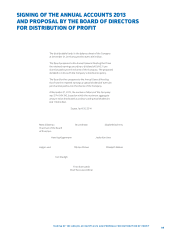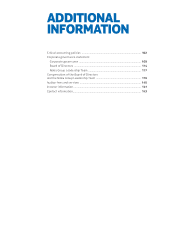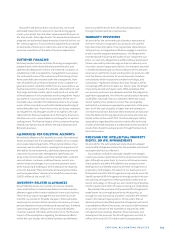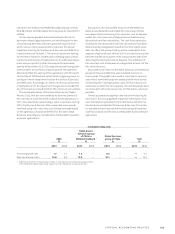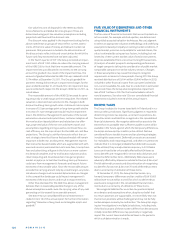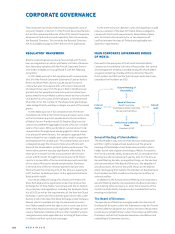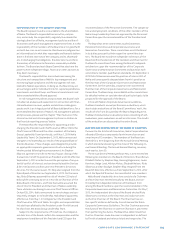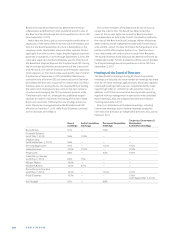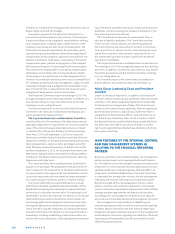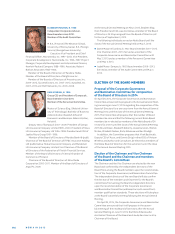Nokia 2013 Annual Report Download - page 111
Download and view the complete annual report
Please find page 111 of the 2013 Nokia annual report below. You can navigate through the pages in the report by either clicking on the pages listed below, or by using the keyword search tool below to find specific information within the annual report.109
CORPORATE GOVERNANCE STATEMENT
RESPONSIBILITIES OF THE BOARD OF DIRECTORS
The Board represents and is accountable to the shareholders
of Nokia. The Board’s responsibilities are active, not pas-
sive, and include the responsibility regularly to evaluate the
strategic direction of Nokia, management policies and the ef-
fectiveness with which management implements them. It is the
responsibility of the members of the Board to act in good faith
and with due care so as to exercise their business judgment on
an informed basis in what they reasonably and honestly believe
to be in the best interests of the company and its sharehold-
ers. In discharging that obligation, the directors must inform
themselves of all relevant information reasonably available
to them. The Board and each Board Committee also have the
power to hire independent legal, fi nancial or other advisors as
they deem necessary.
The Board’s responsibilities also include overseeing the
structure and composition of Nokia’s top management and
monitoring legal compliance and the management of risks
related to Nokia’s operations. In doing so, the Board may set
annual ranges and/or individual limits for capital expenditures,
investments and divestitures and fi nancial commitments not
to be exceeded without Board approval.
In risk management policies and processes the Board’s role
includes risk analysis and assessment in connection with fi nan-
cial and business reviews, update and decision-making pro-
posals and it is an integral part of all Board deliberations. For a
more detailed description of Nokia’s risk management policies
and processes, please see the chapter “Main features of the
internal control and risk management systems in relation to
the fi nancial reporting process” below.
The Board has the responsibility for appointing and dis-
charging the President and Chief Executive Offi cer (CEO), the
Chief Financial Offi cer and the other members of the Nokia
Group Leadership Team (previously, until May , Nokia
Leadership Team). On September , , Nokia announced
changes to its leadership as a result of the proposed Sale of
the D&S Business. These changes were designed to provide
an appropriate corporate governance structure during the
interim period following the announcement. As Stephen
Elop was agreed to transfer to Microsoft upon closing of the
transaction, he left his position as President and CEO eff ective
September , in order to avoid the perception of any po-
tential confl ict of interest, and continued to lead the Devices
& Services business as Executive Vice President, Devices &
Services. For the same reason, Mr. Elop also resigned from the
Nokia Board of Directors on September , . On the same
day, Risto Siilasmaa assumed the role of interim CEO role of
Nokia while continuing to serve in his role as Chairman of the
Nokia Board of Directors, and Timo Ihamuotila assumed the
role of interim President and Chairman of Nokia Leadership
Team while also continuing to serve as Chief Financial Offi cer.
On April , , Nokia announced its new strategy and con-
sequently, changes to its leadership. Nokia Board appointed,
eff ective as from May , Rajeev Suri the President and
Chief Executive Offi cer of Nokia. His rights and responsibilities
include those allotted to the President under Finnish law and
he also chairs the Nokia Group Leadership Team.
Subject to the requirements of Finnish law, the independ-
ent directors of the Board confi rm the compensation and the
employment conditions of the President and CEO upon the
recommendation of the Personnel Committee. The compensa-
tion and employment conditions of the other members of the
Nokia Group Leadership Team are approved by the Personnel
Committee upon the recommendation of the President and
CEO.
The Board has three committees: Audit Committee,
Personnel Committee and Corporate Governance and
Nomination Committee. These committees assist the Board
in its duties pursuant to their respective committee char-
ters. The Board elects and the independent directors of the
Board confi rm the election of the members and Chairmen for
the Board’s committees from among the Board’s independ-
ent directors upon the recommendation of the Corporate
Governance and Nomination Committee and based on each
committee’s member qualifi cation standards. On September,
Risto Siilasmaa assumed the position of interim CEO of
Nokia and consequently stepped down from his position as
the Chairman of the Corporate Governance and Nomination
Committee. On the same day, Jouko Karvinen was elected
the Chairman of the Corporate Governance and Nomination
Committee. The Board may also establish ad hoc committees
for detailed reviews or consideration of particular topics to be
proposed for the approval of the Board.
In line with Nokia’s Corporate Governance Guidelines,
the Board conducts annual performance evaluations, which
also include evaluations of the Board Committees’ work, the
results of which are discussed by the Board. Regarding ,
the Board conducted an evaluation process consisting of self-
evaluations, peer evaluations as well as interviews. The results
of the evaluation are discussed by the entire Board.
ELECTION AND COMPOSITION OF THE BOARD OF DIRECTORS
Pursuant to the Articles of Association, Nokia Corporation has
a Board of Directors composed of a minimum of seven and
a maximum of members. The members of the Board are
elected for a term beginning from the Annual General Meeting
in which elected and expiring at the close of the following An-
nual General Meeting. The Annual General Meeting convenes
each year by June .
The Annual General Meeting held on May , elected the
following ten members to the Board of Directors: Bruce Brown,
Elizabeth Doherty, Stephen Elop, Henning Kagermann, Jouko
Karvinen, Helge Lund, Mårten Mickos, Elizabeth Nelson, Risto
Siilasmaa and Kari Stadigh. Stephen Elop resigned from the
Board of Directors eff ective as from September , , after
which the Board of Directors has consisted of nine members.
Nokia Board’s leadership structure consists of a Chairman
and Vice Chairman elected annually by the Board, and con-
fi rmed by the independent directors of the Board, from
among the Board members upon the recommendation of the
Corporate Governance and Nomination Committee. On May,
, the independent directors of the Board elected Risto
Siilasmaa to continue as the Chairman and Jouko Karvinen
as the Vice Chairman of the Board. The Chairman has cer-
tain specifi c duties as defi ned by Finnish law and the Nokia
Corporate Governance Guidelines. The Vice Chairman assumes
the duties of the Chairman in case the Chairman is prevented
from performing his duties. The Board has determined that
the Vice Chairman Jouko Karvinen is independent as defi ned
by Finnish standards and relevant stock exchange rules. The


